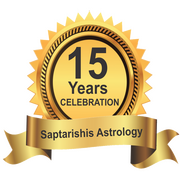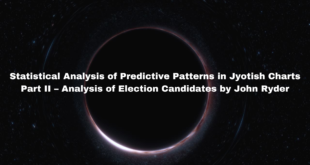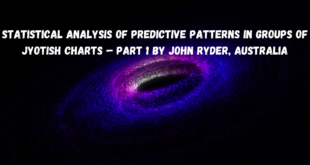Related Articles
Translator: Sreeram Medapali
Copy Editor: Shanmukha
Article Submission: Aug, 2008
Readership Level: Very Advanced
- Introduction
In the science of predictive astrology, there are 3 famous systems – Parasara, Jaimini and Yavana. Among them, Jamini School gives remarkable and specific predictions using distinctly different methods from the other two. In this paper, an overview of Jaimini system is discussed with the help of Somanatha Mishra’s Kalpalatha a commentary on Jaimini Sutras.
1.1 Parasara System:
In this system delineation of twelve bhavas (houses) that is Tanu, Dhana etc., and Dasa and Antara dasa results occupy a major role. In this system, results related to the bhavas like Tanu, Dhana, Bhratri, Matri bhava etc are determined by the relationship between planets and bhavas and fructification of results is determined from the results of dasa – antardasa. The dasa system in this school is planet based and Vimsottari, Astottari, Shodashottai etc. dasas are discussed. The application of these dasas is decided by the time of birth of the native i.e. specific combinations on the horoscope, yet; in general, the results are decided by Vimsottari dasa only.
1.2 Yavana System:
In this school of thought, the results are decided by the following six types of combinations Grahaja: The results that planet give of its own, i.e. the signification of planet
2 | Bhavaja: | The results by significations of the houses |
3 | Rashija: | The results by the signification of signs Aries, Taurus etc. |
- Graha Bhavaja: The result of a planet in a particular house.
5 | Graha Rasija: | The results of planet in a particular sign |
6 | Graha Yogaja: | The results of the combination planets, signs and houses |
These six types of results are modified by the permutations and combinations of individual significations of signs and planets, combinations of two, three planets etc. The dasa system in this school depends on the longevity and then selecting the suitable dasa system.
1.3 Jaimini System:
Jaimini system while absorbing the topics from the above two systems, also mentions other topics and distinct / peculiar topics / subject matters. The dasa system is mainly Rasi (Sign) based and is drastically different from the above two systems. It is found that Jaimini concepts are also dealt with in Parasara Hora Sastra (BPHS) by Sage Parasara. Due to non availability of complete and unadulterated version of BPHS, it is difficult to understand the Jaimini concepts with the available BPHS versions.
2.0 Kalpalatha1 – An Exposition of Jaimini
Somanatha Mishra, son of Krishna Mishra wrote Kalpalatha, his commentary on Jaimini Sutras. He explained in the work about the concept introduced in the Jaimini Upadesa Sutras chapter wise and indicated that Sage Jaimini wrote 8 Chapters (Adhyayas) in Sutra form, 4 Chapters each on mathematical and predictive part. We explain in the following lines the introductory chapter given by Somanatha Mishra for the benefit of readers.
Translation: Maharshi Jaimini, the divine incarnation, explained mathematical part (Ganita Sastra) (theory related to calculation of planets, tithi etc) in four chapters and predictive part in another four chapters. Through these four chapters on Predictive part He enumerated means to predict good and bad results for all lives including animals, to determine the longevity, the knowledge about netherworlds, predictions regarding the lives of kings, using Karaka, lagna, drekkana and navamsa.
Somanatha mentioned the various topics discussed in the Jaimini Sutras chapter wise in the following lines.
अि न शा ्ेूथमा ायेसज्ञां कारक पद राजयोगािद िनण यत।े
Translation: In this Upadesa sasthra, Sage Jaimini explained the significations of signs, karaka planets, Arudha Pada, Rajayoga and their respective results in the first chapter.
Explanation: There are four chapters each comprising four padas (quarter) and hence resulting in total 16 padas.
First quarter contains 35 sutras and discusses
- Rasi Drishis
- Argala
- Chara karaka Æ Atma Karaka (AK) etc.
- Arudha Pada
Second quarter contains 121 sutras, discusses Karakamsa and houses from Karakamsa Lagna. 3rd quarter contains 45 sutras, explains various Dhana and Rajayogas from Arudha Lagna (AL). Fourth quarter deals with the spouse, children, brothers and devotion from Upapada lagna (UL) in 49 sutras. So, in total, the first Chapter contains 250 sutras.
This chapter lists 40 dasa systems in total.
ि तीया ायतेुल कारक आयदाुयर्दशािवशषािद।े
Translation: In second Adhyaya (Chapter), calculation of longevity from natal lagna and Karaka lagna, determination of maraca planets, various dasa systems and their respective calculation were discussed.
ि तीया येच ािरंश शानयन।ं
Translation: Forty sign dasas and their calculation were explained in 2nd chapter.
Explanation: In Jaimini Sutras 1st quarter of 2nd chapter, Sage Jaimini explained calculation of longevity of the native, Ayurdasas and respective Maraka planets, and calculation of antara dasa in total 60 sutras. In 2nd quarter Sage explained the death inflicting periods for Father, Mother, Spouse and the co-borns and the cause of their death in total 33 sutras. In 3rd quarter, He mentioned variations of different dasas, strength of signs and planets, death inflicting periods for Matri, Pitri bhavas etc. in total 30 sutras. In 4th quarter, He explained variations of Chara Dasa, calculation of various other sign dasas and general results of Rasi Dasas in 37 sutras.
Somanatha explained these 40 dasas, but didn’t explain the calculation of them. He directed the readers to read the “Mula Sastra2” by Kalidasa. Somanatha mentioned the following dasas in the 2nd chapter of Kalpalatha.
- Atma Dasa
- Chara Dasa
- Varnada Dasa – 4 types
- Nakshatra Dasa
- Navamsa Dasa
- Sthira Dasa
- Shoola Dasa
- Prakarantara Shoola Dasa (Another variation of Shoola Dasa)
- Yoga Dasa also known as Yogartha Dasa
- Prakarantara Chara Dasa (Another variation of Chara Dasa) – 3 Types
- Karaka Dasa
- Chara Paryaya Dasa
- Sthira Paryaya Dasa – 2 Types
- Nakshatra Bheda Dasa
- Trikona Dasa
- Drishti (Drik) Dasa
- Kendra Dasa
Somanatha extensively dealt with the calculation of the longevity of the native, detemination of Maraka (Daeth inflicting) planets, Maraka planets for Mother and Father etc.
Raghava Bhatta, the author of “Jataka Sara Sangraha” explained the following 12 Ayur (longevity) dasas in the Ayurdaya Part (Longevity Chapter).
- Hora Dasa
- Darpana Dasa
- Soola Dasa
- Maheswara Dasa
- Copy Editor’s Note: Mula sastra means the main (root) science. It looks this Jaimini Sastra was more exhaustive than that is available to us. Also one can note from the list of the dasas that today’s available knowledge base have not even heard of these dasas hence we must be thankful to Madura Sastrigaru to atleast mention these new dasas from Kalpalatha to increase our inquisitiveness to earn that knowledge.
- Atma Nadi Dasa
- Sthira Dasa
- Varnada Dasa
- Chara Paryaya Dasa
- Atmanobhava Pamsa Dasa
- Jaya Bhava Pamsa Dasa
- Atmamsa Bhava Pamsa Dasa
- Drekkana Dasa
Mostly the first and second chapters of Jaimini Sutras are popular. We have the following commentaries for the 1st and 2nd chapters available and even in BPHS; there is an exposition in verses of the concepts in 1st and 2nd chapter only.
- Neelakantha3, being most popular
- Bala Krishnananda Swami
- Venkateswara Vriiti
- Guru Vritti
- Kesava Daivajna Vriddha Karikas
- Jaimini Sutrartha Prakasika
- Jaimini Padyamritam
- Achyutananda Jha Vyakhya
- Sitaram Jha Vyakhya
- Commentary by B.Suryanarain Rao, published by Dr. B.V.Raman
Somanatha writes the following, in the 2nd chapter of Kalpalatha.
तृतीया ायेिे णवैषियक राजयोग आयदाुयर्अ रंग षोडशदशा नयनं ीलक्षणिनच।
Translation: Sage Jaimini gave exposition of Rajayoga, calculation of longevity according to Drekkana, 16 other dasas, female horoscopy in the 3rd chapter.
Explanation: Sage Jaimini explained Rajayogas from Drekkana chart in the first quarter, determination of longevity according to Drekkena and 16 types of Rasi dasas according to Antaranga Sashtra (explained later in this paper) in 2nd quarter, female horoscopy in 3rd quarter and determination of Yoga Bhanga (Cancellation of Yogas), various dasas, Argala, Raja Yoga according to Amsa (Navamsa) in the 4th quarter of 3rd chapter.
चथधाु ायर्ेतुमृित लक्षण नानादशसेचारं परलोक िवधायक चतदुशर्दशानयनम।् इित म ूयोजनािन॥
- Publisher: Till date all English publications of Jaimini Sutras from rest of India except Andhra
Pradesh & Banaras have only followed Neelakantha’s commentary hence there is an urgent need to get the other commentaries translated if one has to understand basics of Jaimini.
Translation: Sage Jaimini gave exposition of nature of death, visiting other countries, life after death and 14 types of dasas.
Explanation: In the commentary of Somanatha, Drekkana plays an important role. He writes Drekkana is Antaranga sastra (which is an implied secret system). He writes
तृतीया ायेल कारक ूव ृ शा बिहरंग ात ि्े ण शा अ रंग ात।्
अ रंगबिहर योर रंगो बलीयान॥्
इित ायनेअ र शा गाणरी ैव फलािधकंूव िमितृ ायने गाना ायः ूव ः॥ृ
Translation: In Somanatha’s interpretation, 3rd chapter of Jaimini Sutras deals with the Antaranga system. The results described by the Lagna, Karaka, Karakamsa and Arudha are called Bahiranga system (As apparent/ external system), where as 3rd chapter deals with Antaranga system (An implied system) of Drekkana4. And since the implied is more powerful than the apparent, the 3rd chapter of Jaimini Sutras is very important and the results ascribed shall be read from the Drekkana chart.
Explanation: We could fortunately get hold of the Neelakantha5 commentary on 3rd and 4th chapters of Jaimini sutras which I could transcribe from the manuscript available with our Gurudeva Sri Venkata Ramana Daivajna. We learnt that it was printed in Bombay decades ago, but isn’t traceable. Sri B.V.Raman published English commentary by Sri S.K.Kar, Calcutta on these 3rd and 4th chapters. But after studying the manuscript of Neelakantha commentary, we could find that there is a lot of difference in Sutras between Neelakantha’s commentary and Sri S.K.Kar’s commentary. Neelakantha commentary has 145 sutras in 4th quarter of 3rd Chapter, where as these Sutras are no resemblance with the Sutras given by Sri S.K.Kar. Yet, these sutras in Sri S.K.Kar’s commentary are in resemblance with the manuscript No. 13727 of Madras Oriental Libray, Chennai. So it is doubtful whether the manuscript available with us of Neelakantha commentary is original or not.
- Copy Editor’s Note: In Jaimini system, Drekkana chart has an important role in determining Rajayoga next only to Rasi chart. Though Parivriiti Drekkana chart is popular in this system, yet Somanatha gave another Parivriiti Drekkana popularly known as Somanatha Drekkana. Readers do well to learn it from Standard work like Jaimini Sutramritam by Rangacharya, 1st
- Copy Editor’s Note: This is fantastic. It is not still available in print.
We6couldn’t trace out the complete work of Somanatha’s Kalpalatha, but up to the commentary for 1st quarter of 4th chapter only. And again, the Somanatha commentary on 3rd and 4th chapters differs distinctly with S.K.Khar’s commentary.
3.0 Important Parameters for Analysis of an Horoscope
Somanatha mentioned four important parameters for the analysis of a horoscope.
- Lagna
- Karaka
- Drekkana
- Amsaka (He interpreted Amsaka as Arudha Pada)
The following 5 lagnas useful for determination of Rajayoga on the horoscope
- Tripravana Lagna
- Sri Lagna
- Indu Lagna
- Vilagna
- Bhagadhikamsa Lagna (Karakamsa Lagna)
The following other lagnas can also be effectively used, but these are secondary7.
- Hora Lagna
- Ghati Lagna
- Chandra Lagna
Yogada and Kevala Grahas play an important role in determining the Raja Yoga and Avayoga of the horoscope.
The planet aspecting lagna is called Drashta or Yogada planet and ‘Argala shall be calculated only to Yogada planet only8’. The strength and influence on this planet shall decide the extent of Raja Yoga of the horoscope.
- Copy Editor’s Note: This author couldn’t get the commentary for 2nd, 3rd, 4th quarters of 4th chapter even after consulting available manuscripts in Adyar Manuscript Library and Tanjavur (Tanjore) Saraswati Mahal Library.
- Publishers Note: One must note that here the word secondary has been used for Hora, Ghatika & Moon Asc whereas till date all of us Jaimini aspirants have been using them as the main primary factor to determine rajayogas; we remain indebted to our author for opening our eyes.
- Publishers Note: This point on usage of Argala cannot be ignored and Maduraji, shows us that the way generally Argala has been used for the last few decades is totally wrong & at the same time his experience of differential application of Argala as brought out by Somanatha Mishra of Kalpalatha fame might have made him change his stance of usage of Argala that he wrote in 1962. As is the true parampara of scholars to always quote verse from relevant manuscript so as not to misguide students in learning of shastra, here is the verse for Argala from Madurajis copy of Kalpalatha
सवऽािपर् ि ार मिधकृ ैव
अगलर्पिरज्ञानम।्न तुिवल कारकयोः॥
4.0 Applicability of Dasas – The Speciality
4.1 Raja Yoga Dasas
Out of dasas mentioned in 2nd Chapter of Jaimini Sutras only 11 dasas can be applied to Rajayoga horoscopes. Out of them only 5 are useful for the horoscopes of Kings.
Below you would find 4 dasas which are equally applicable for any rajayoga horoscope and the results gotten similar with any two dasas always come true.
- Yogartha Dasa
- Manduka Pluti Dasa (Pluti means Jump).
- Labhadhipastha Drekkana Dasa
- Bhava Rahasya Dasa
4.2 Ordinary Dasas
The following dasas are applicable for Kings with no Rajayoga or for the Kings with Rajayoga Bhanga (Cancellation of Rajayoga) in the horoscope.10
- Nakshatra Bheda Dasa
- Nakshatra Raja Dasa
- Nisarga Dasa
- Chara Dasa
- Chara Paryaya Dasa
- Sthira Paryaya Dasa
- Gochara (Trikona) Dasa
4.3 Ayur Dasas for Longevity
Somanatha Mishra mentioned that Longevity should be calculated from lagna, lord of 8th, Moon, Hora Lagna, Ghatika Lagna and Drekkana. The following dasas are useful for longevity.
- Bramha Graha Dasa
- Varnada Dasa
- Chara Dasa
- Chara Paryaya Dasa
5.0 Conclusion:
sarvatrāpi draṣṭāra madhikṛtyaiva argala parijñānam |na tu vilagna kārakayoḥ ||
Literal Translation: Argala shall always be calculated ONLY from the apecting planet. Never from the lagna (Vilagna) or from the Karaka (Presumably Atmakaraka planet).
- Copy Editor’s Note: Readers can find the exposition of this dasa only in Jataka Sara Sangraha By Raghava Bhatta, bhava means house, rahasya means secret.
- Copy Editor’s Note: The heading says Oridinary dasas whereas the explanation given means it is for Kings only, we are unable to ratify this contradiction from Maduraji due to his ill-health.
Thus, Somanatha Mishra mentioned many parameters for the analysis of horoscope, which are distinctly different from Parasara and Yavana systems. His father Krishna Mishra mentioned much more details in his treatise “Phalaratnamala”. He claimed to have followed Sarvajna Muni (Sage Sarvajna) in writing the book. It looks that the school of these two great commentators of Jaimini system is very ancient and much more exhaustive in content and drastically differs from the modern commentators. And since this wonderful Jaimini Tradition is lost to us, it is difficult to understand this system comprehensively. It is learnt that Jain Astrologers also have done excellent work on this system, if a massive hunt is carried out in the manuscript libraries available across India, it is hoped that this system could be revived to the maximum possible extent. We hope suitable steps should take place in near future by eminent scholars.
अथ भगवानाचायःर्कालपज्ञानाथ गिणत शा ंसऽा ायू चत युंिन त ारा सवषा ंज नामिपू फलपिरज्ञानाथ ूभरुंजनाथ च आयज्ञाुनर्परलोक ज्ञानाथ च कारक ल िे ण नवशकािदिभःं उपदशा ाये चत युंूकटीकरोित
Learn Astrology: Join Our Upcoming Astrology Classes — Click Here
Learn Astrology: Join Our Recorded Astrology Classes — Click Here
 Saptarishis Astrology Magazine Into Creating Astrologers
Saptarishis Astrology Magazine Into Creating Astrologers






